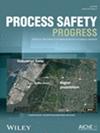定量风险分析在防火中的应用
IF 1
4区 工程技术
Q4 ENGINEERING, CHEMICAL
引用次数: 0
摘要
摘要:被动防火是石化加工厂防火的核心内容之一。这一一般类别通常被称为防火,在美国石油协会(API)推荐实施细则(RP) 2218中有规定。本RP为防火材料的选择和应用提供了指导方针,主要采用定性风险评估方法。该逻辑侧重于基于系统属性的粗略特征并结合设备布局来预测池火。虽然水池火灾的影响通常是局部的,但喷射火灾可以影响更大的区域。API RP 2218在附录中提到了喷射火灾,因为其不可预测的性质,将水池火灾暴露作为结构防火的默认基础。为了正确考虑这两种火灾类型,可以使用定量风险分析(QRA)工具对火灾暴露进行评估,该工具结合了各种事故场景、天气条件和释放方向的喷射和水池火灾影响。通过评估火灾的热辐射影响与钢结构构件脆弱性的关系,可以实现基于QRA的PFP放置方法。这种方法的好处是将PFP应用于最需要的地方,以最好地保护公司的基础设施。本文章由计算机程序翻译,如有差异,请以英文原文为准。
Application of quantitative risk analysis to fireproofing
Abstract One of the core elements of fire protection for petrochemical processing plants is the consideration of passive fire protection (PFP). This general category, often referred to as fireproofing, is addressed in the American Petroleum Institute (API)‐recommended practice (RP) 2218. This RP provides guidelines for the selection and application of fireproofing with what is mostly a qualitative risk assessment approach. The logic focuses on predicting pool fires based on rough characterizations of system properties combined with equipment layout. Although pool fire impacts are often localized, jet fires can affect larger areas. API RP 2218 addresses jet fires in an appendix because of their unpredictable nature, leaving pool fire exposures as the default basis for structural fireproofing. To properly account for both fire types, fire exposure can be evaluated with quantitative risk analysis (QRA) tools that incorporate both jet and pool fire impacts for a wide variety of accident scenarios, weather conditions, and release orientations. By evaluating the thermal radiation impacts of fires in relation to the vulnerability of steel structural elements, a QRA‐based approach to placement of PFP can be achieved. This approach has the benefit of applying PFP where it is needed the most, to best protect a company's infrastructure.
求助全文
通过发布文献求助,成功后即可免费获取论文全文。
去求助
来源期刊

Process Safety Progress
工程技术-工程:化工
CiteScore
2.20
自引率
10.00%
发文量
99
审稿时长
6-12 weeks
期刊介绍:
Process Safety Progress covers process safety for engineering professionals. It addresses such topics as incident investigations/case histories, hazardous chemicals management, hazardous leaks prevention, risk assessment, process hazards evaluation, industrial hygiene, fire and explosion analysis, preventive maintenance, vapor cloud dispersion, and regulatory compliance, training, education, and other areas in process safety and loss prevention, including emerging concerns like plant and/or process security. Papers from the annual Loss Prevention Symposium and other AIChE safety conferences are automatically considered for publication, but unsolicited papers, particularly those addressing process safety issues in emerging technologies and industries are encouraged and evaluated equally.
 求助内容:
求助内容: 应助结果提醒方式:
应助结果提醒方式:


